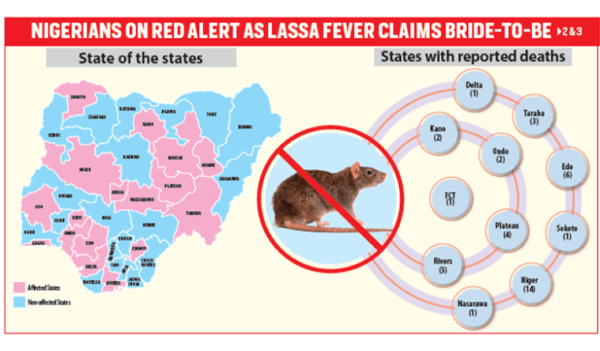
After the Ebola crisis of 2014, Nigeria is now facing the spread of Lassa Fever.
Lassa Alert, a collective led by Federal Ministry of Health. The Nigeria Center for Disease Control and Partners are focusing to spreading awareness to help stop the spread of the disease. Lassa Alert has shared key information about the disease which has now been confirmed in several states around Nigeria.
Over 40 people in 10 states have been confirmed dead since this outbreak started.
Key facts
Lassa fever is an acute viral haemorrhagic illness of 1-4 weeks duration that occurs in West Africa.
The Lassa virus is transmitted to humans via contact with food or household items contaminated with rodent urine or faeces.
Person-to-person infections and laboratory transmission can also occur, particularly in hospitals lacking adequate infection prevent and control measures.
Lassa fever is known to be endemic in Benin (where it was diagnosed for the first time in November 2014), Guinea, Liberia, Sierra Leone and parts of Nigeria, but probably exists in other West African countries as well.
The overall case-fatality rate is 1%. Observed case-fatality rate among patients hospitalized with severe cases of Lassa fever is 15%.
Early supportive care with rehydration and symptomatic treatment improves survival.
Lassa fever is an acute viral haemorrhagic illness of 1-4 weeks duration that occurs in West Africa.
The Lassa virus is transmitted to humans via contact with food or household items contaminated with rodent urine or faeces.
Person-to-person infections and laboratory transmission can also occur, particularly in hospitals lacking adequate infection prevent and control measures.
Lassa fever is known to be endemic in Benin (where it was diagnosed for the first time in November 2014), Guinea, Liberia, Sierra Leone and parts of Nigeria, but probably exists in other West African countries as well.
The overall case-fatality rate is 1%. Observed case-fatality rate among patients hospitalized with severe cases of Lassa fever is 15%.
Early supportive care with rehydration and symptomatic treatment improves survival.
Background
Though first described in the 1950s, the virus causing Lassa disease was not identified until 1969. The virus is a single-stranded RNA virus belonging to the virus family Arenaviridae.
Though first described in the 1950s, the virus causing Lassa disease was not identified until 1969. The virus is a single-stranded RNA virus belonging to the virus family Arenaviridae.
About 80% of people who become infected with Lassa virus have no symptoms. One in five infections result in severe disease, where the virus affects several organs such as the liver, spleen and kidneys.
Lassa fever is a zoonotic disease, meaning that humans become infected from contact with infected animals. The animal reservoir, or host, of Lassa virus is a rodent of the genus Mastomys, commonly known as the “multimammate rat.” Mastomys rats infected with Lassa virus do not become ill, but they can shed the virus in their urine and faeces.
Because the clinical course of the disease is so variable, detection of the disease in affected patients has been difficult. However, when presence of the disease is confirmed in a community, prompt isolation of affected patients, good infection protection and control practices and rigorous contact tracing can stop outbreaks.
Symptoms of Lassa fever
Symptoms of Lassa fever
No comments:
Post a Comment